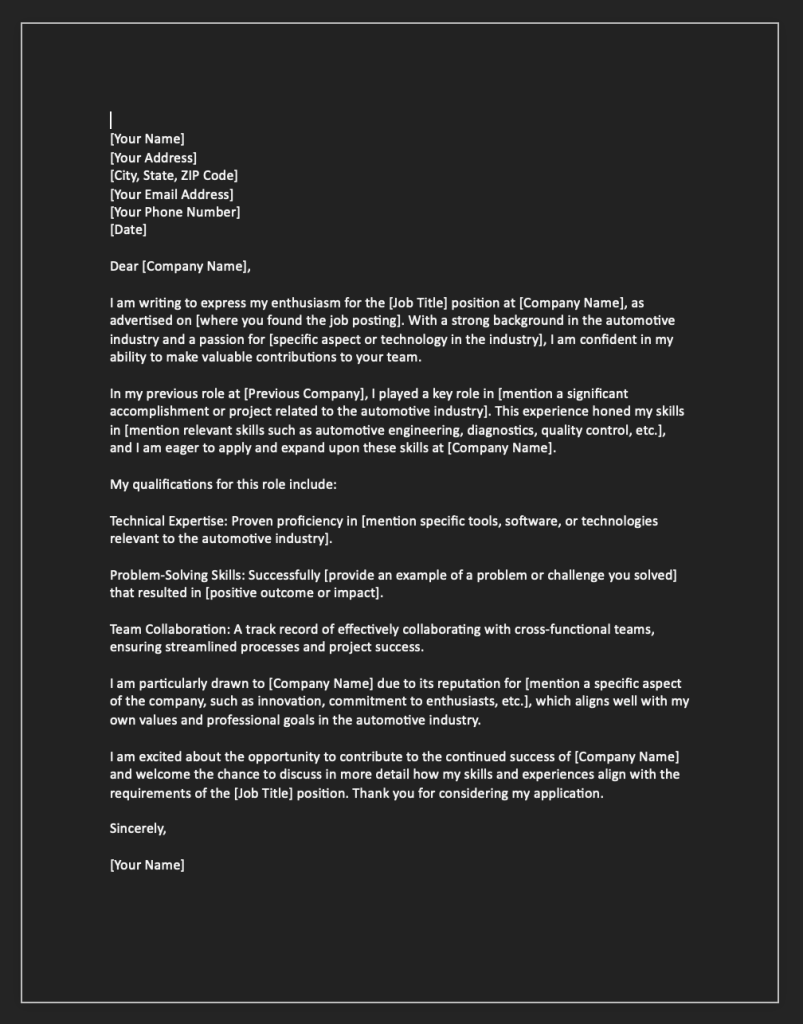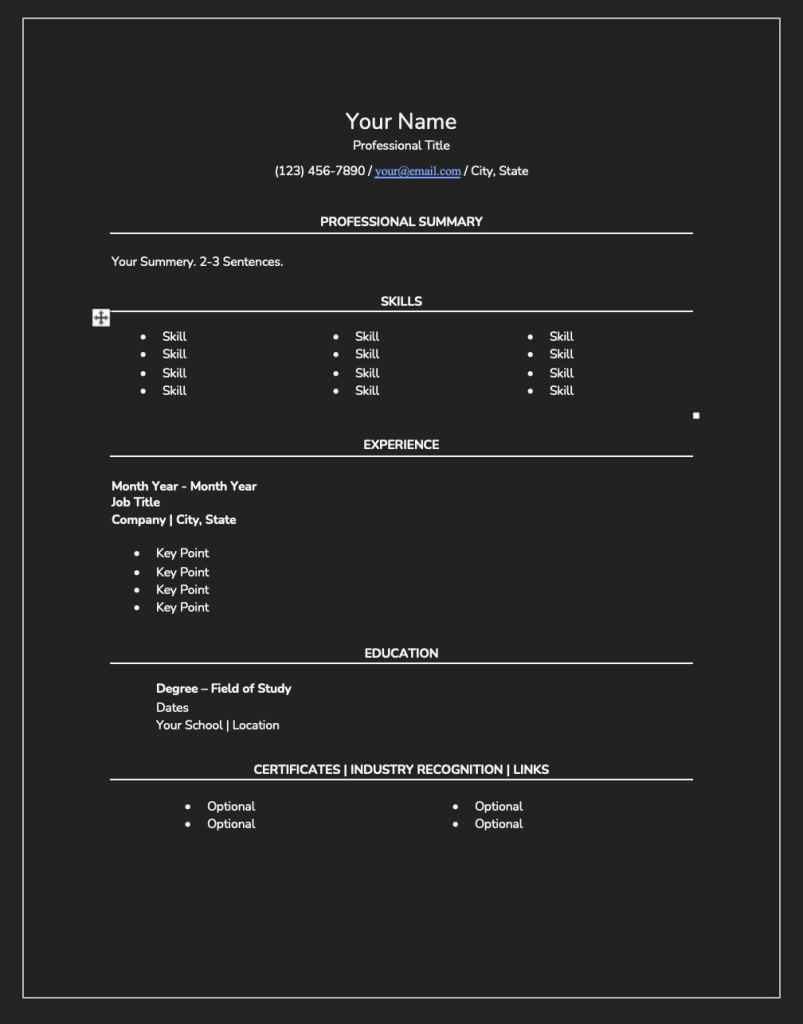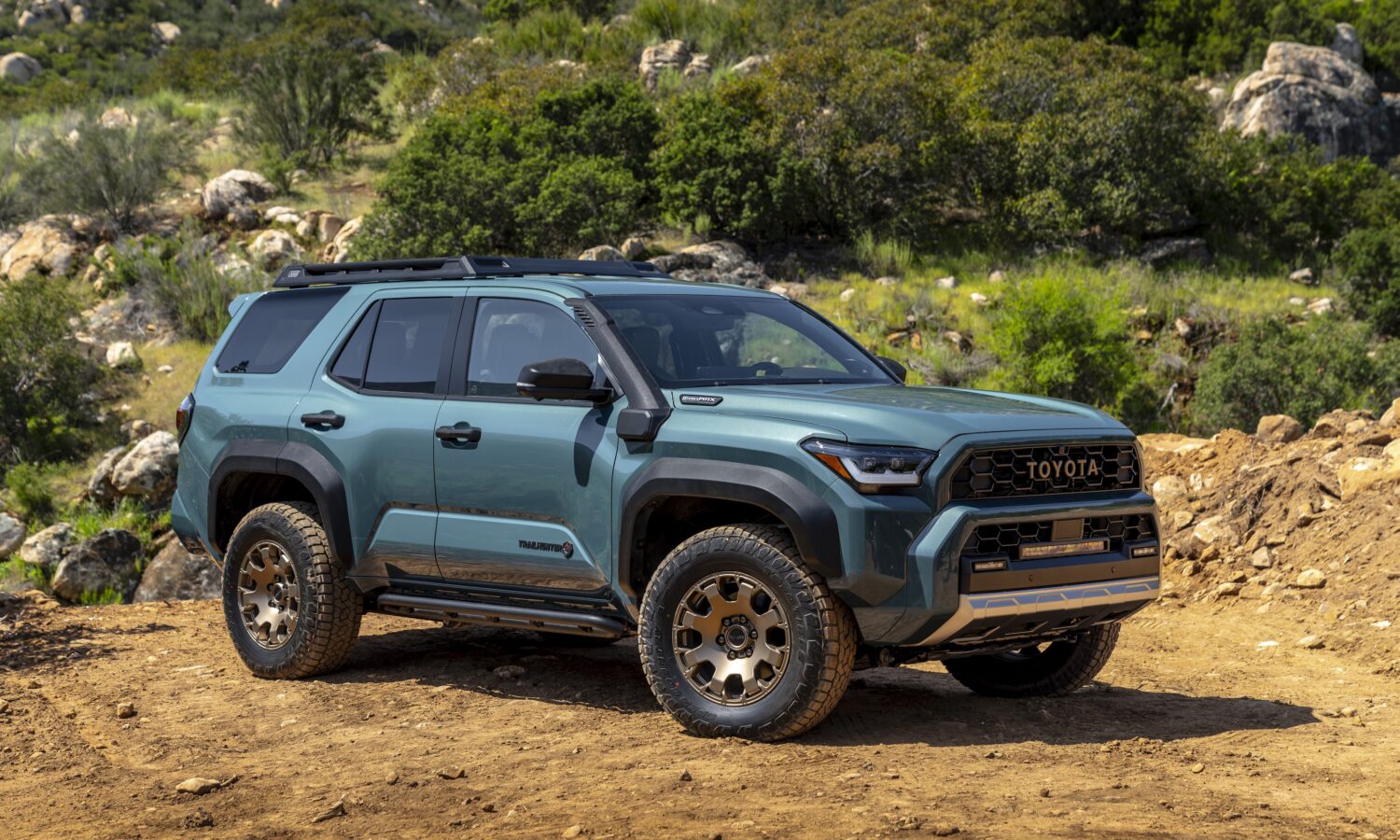Automotive Industry Job
Resume & Cover Letter Templates
ZENDO Motorsport Club has created this Automotive Industry resource page to help members update and write better cover letters and resumes to have a better chance of landing your next job.
Cover Letter Template
Download and customize this automotive industry-specific cover letter.
Resume Template
Download and customize the automotive industry resume designed and optimized for resume scanners.
Use AI to Help for FREE
ChatGPT, like other language models developed by OpenAI, can be used for a variety of purposes. We recommend using it to get ideas, proofreading and rewrite sentences. Also it’s free!
Cover Letter Tips
Writing a cover letter for the automotive industry requires careful attention to detail and a focus on showcasing your relevant skills and experiences. Here are some tips to help you create an effective cover letter:
Contact Information:
- Include your contact information at the top of the cover letter, including your name, address, phone number, and email address.
Salutation:
- Address the cover letter to a specific person if possible. If you don’t have a name, use a general salutation such as “Dear Hiring Manager.”
Introduction:
- Start with a strong opening paragraph that clearly states the position you are applying for and expresses your enthusiasm for the role.
Research the Company:
- Demonstrate your knowledge of the company by mentioning specific details about its products, services, or recent achievements. This shows that you’ve done your homework and are genuinely interested in the company.
Highlight Relevant Experience:
- Clearly outline your relevant automotive industry experience. Discuss your achievements, skills, and any specific projects or accomplishments that set you apart.
Emphasize Skills:
- Highlight skills that are particularly relevant to the automotive industry, such as technical expertise, problem-solving abilities, attention to detail, and familiarity with industry-specific tools and software.
Quantify Achievements:
- Whenever possible, quantify your achievements with specific numbers or percentages. This adds credibility to your claims and gives employers a clearer understanding of your impact.
Tailor the Letter to the Job:
- Customize your cover letter for each position you apply to. Address the specific requirements and qualifications outlined in the job description.
Show Enthusiasm:
- Express your passion for the automotive industry and convey your excitement about contributing to the company’s success. This helps create a positive impression and indicates that you’re genuinely invested in the opportunity.
Address Employment Gaps:
- If you have employment gaps, briefly explain them in a positive light. Focus on any skills or experiences gained during that time that are relevant to the automotive industry.
Conclude Professionally:
- End your cover letter by expressing your gratitude for the opportunity to apply and your enthusiasm for the possibility of an interview. Include a call to action, such as expressing your eagerness to discuss your qualifications further.
Professional Closing:
- Use a professional closing such as “Sincerely” or “Best Regards,” followed by your typed name. If you’re sending a physical copy, leave space for your signature.
Proofread:
- Before submitting your cover letter, carefully proofread it for errors in grammar, spelling, and punctuation. A polished cover letter reflects your attention to detail and professionalism.
Remember that a cover letter is your opportunity to make a strong first impression. Tailor it to the specific job and company, and focus on how your skills and experiences align with the needs of the automotive industry.
Resume Tips
Creating an effective resume for the automotive industry requires a strategic approach to showcase your relevant skills, experiences, and achievements. Here are some tips to help you craft a compelling automotive industry resume:
Contact Information:
- Include your full name, phone number, email address, and LinkedIn profile (if applicable). Make sure your contact information is easily visible at the top of the resume.
Objective or Summary (Optional):
- Consider including a brief objective or summary at the beginning that highlights your career goals and what you bring to the table. This section is optional but can be useful to provide a quick overview.
Tailor to the Job:
- Customize your resume for each job application by emphasizing the skills and experiences most relevant to the specific position you’re applying for. Use keywords from the job description.
Professional Experience:
- Highlight your work experience in reverse chronological order. Provide detailed descriptions of your roles and responsibilities, focusing on accomplishments and contributions.
- Quantify your achievements whenever possible. For example, mention improvements in efficiency, cost savings, or successful project outcomes.
Technical Skills:
- Include a section that highlights your technical skills relevant to the automotive industry. This may include proficiency in specific software, tools, diagnostic equipment, or technical certifications.
Education:
- List your educational background, including degrees, institutions, and graduation dates. If you have relevant coursework or academic projects, consider mentioning them.
Certifications and Training:
- Showcase any certifications, training, or workshops relevant to the automotive industry. This could include certifications in specific technologies, safety protocols, or industry standards.
Achievements and Awards:
- If you have received any awards or recognition for your work in the automotive field, include them in a separate section to draw attention to your accomplishments.
Problem-Solving and Results:
- Use specific examples to demonstrate your problem-solving skills and highlight the positive outcomes of your contributions. This could involve resolving technical issues, improving processes, or implementing cost-saving measures.
Adaptability and Continuous Learning:
- Showcase your ability to adapt to new technologies and your commitment to ongoing professional development. The automotive industry is dynamic, and employers value individuals who stay updated on industry trends.
Attention to Detail:
- Highlight your attention to detail, particularly in roles that involve precision, quality control, or safety standards. Employers in the automotive industry often seek candidates with a strong focus on detail.
References:
- Unless explicitly requested, you can omit references from the resume. However, be prepared to provide them upon request.
Formatting and Readability:
- Keep the resume well-organized, use a clean and professional layout, and ensure that it is easy to read. Use bullet points for easy scanning.
Review and Proofread:
- Before submitting your resume, carefully review and proofread it to catch any errors in grammar, spelling, or formatting.
Remember, your resume is a marketing tool, and it should effectively communicate your value to potential employers in the automotive industry. Tailor it to showcase your strengths and align with the specific requirements of the job you’re applying for.










